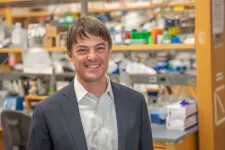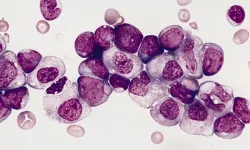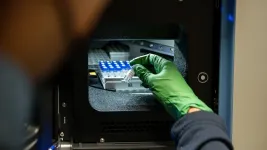(Press-News.org) A new study has shown that bumblebees pick up new “trends” in their behaviour by watching and learning from other bees, and that one form of a behaviour can spread rapidly through a colony even when a different version gets discovered.
The research, led by Queen Mary University of London and published in PLOS Biology, provides strong evidence that social learning drives the spread of bumblebee behaviour – in this case, precisely how they forage for food.
A variety of experiments were set up to establish this. The researchers designed a two-option puzzle box that could be opened either by pushing a red tab clockwise or a blue tab counter-clockwise to reveal a 50 per cent sucrose solution reward.
‘Demonstrator’ bees were trained to use either the red or blue tabs, with ‘observer’ bees watching. When it was the observers’ turn to tackle the puzzle, they overwhelmingly and repeatedly chose to use the same method that they had seen, even after discovering the alternative option. This preference for the taught option was maintained by whole colonies of bees, with a mean of 98.6% of box openings made using the taught method.
The importance of social learning to the acquisition of puzzle box solutions was also illustrated through the control group, which lacked a demonstrator. In this group, some bees managed to open the puzzle boxes, but did so far fewer times than those who benefitted from seeing another bee do it first. The median number of boxes opened in a day by the observer bees with a demonstrator was 28 boxes a day, whereas it was only 1 for the control colony.
In an additional experiment, the researchers put both ‘blue’ and ‘red’ demonstrators into the same populations of bees. In the first population, 97.3% of the 263 incidences of box-opening by observers by day 12 used the red method. In the second population, observers preferred the blue method over the red on all days except one. In both cases, this demonstrated how a behavioural trend might emerge in a population in the first place – for the most part, due to experienced bees retiring from foraging and new learners arising, rather than any bees changing their preferred behaviour.
Similar results from similar experiments have been used in species such as primates and birds to suggest that they, like humans, are capable of culture. If bumblebees are capable of this, too, this could potentially explain the evolutionary origin of many of the complex behaviours seen among social insects. It might be possible that what now appears instinctive could have been socially learnt, at least originally.
Dr Alice Bridges, the lead author from Queen Mary University of London, said: “Bumblebees – and, indeed, invertebrates in general - aren’t known to show culture-like phenomena in the wild. However, in our experiments, we saw the spread and maintenance of a behavioural “trend” in groups of bumblebees – similar to what has been seen in primates and birds. The behavioural repertoires of social insects like these bumblebees are some of the most intricate on the planet, yet most of this is still thought to be instinctive. Our research suggests that social learning may have had a greater influence on the evolution of this behaviour than previously imagined.”
Professor Lars Chittka, Professor of Sensory and Behavioural Ecology at Queen Mary University of London and author of the book ‘The Mind of a Bee’, said: “The fact that bees can watch and learn, and then make a habit of that behaviour, adds to the ever-growing body of evidence that they are far smarter creatures than a lot of people give them credit for.
“We tend to overlook the “alien civilisations” formed by bees, ants and wasps on our planet – because they are small-bodied and their societies and architectural constructions seem governed by instinct at first glance. Our research shows, however, that new innovations can spread like social media memes through insect colonies, indicating that they can respond to wholly new environmental challenges much faster than by evolutionary changes, which would take many generations to manifest.”
END
Bumblebees learn new “trends” in their behavior by watching and learning
2023-03-07
ELSE PRESS RELEASES FROM THIS DATE:
UMass Chan investigators identify new pattern recognition system that monitors disease-causing bacteria in C. elegans
2023-03-07
A study published in Immunity by physician-scientist Read Pukkila-Worley, MD, and MD/PhD students Nicholas D. Peterson and Samantha Y. Tse describes a new manner of detecting microbial infection that intercepts pathogen-derived signals of growth to assess the relative threat of virulent bacteria. A nuclear hormone receptor in the nematode C. elegans senses a toxic metabolite produced by the bacterial pathogen Pseudomonas aeruginosa to activate innate immunity. These data reveal an ancient strategy that informs the origins ...
Blood test identifies acute myeloid leukemia patients at greater risk for relapse after bone marrow transplant
2023-03-07
Blood test identifies acute myeloid leukemia patients at greater risk for relapse after bone marrow transplant
A small portion of adults in remission from a deadly blood cancer had persisting mutations that were detected, which predicted their risk of death from having the cancer return
Researchers at the National Institutes of Health show the benefits of screening adult patients in remission from acute myeloid leukemia (AML) for residual disease before receiving a bone marrow transplant. The findings, published in JAMA, support ongoing research aimed ...
Whistleblowers losing faith in media impact
2023-03-07
The whistleblowers who once trusted journalism are losing faith in the institution.
A new study from the University of Georgia found that many whistleblowers who reached out to journalists in the past no longer believe media has the same ability to motivate change, and they feel let down by a system they once trusted.
“If you don’t believe that an outlet or journalist can carry you across the finish line—meaning can affect change, attract enough attention and attract the attention of the right people—then you’re losing faith,” said Karin Assmann, study lead and assistant professor in UGA’s Grady College of Journalism ...
STEP Demo pilot plant achieves supercritical CO2 fluid conditions
2023-03-07
SAN ANTONIO — March 7, 2023 —The Supercritical Transformational Electric Power (STEP) Demo pilot plant, a $155 million, 10-megawatt supercritical carbon dioxide (sCO2) test facility at Southwest Research Institute (SwRI) in San Antonio, developed in partnership with GTI Energy and GE Research and sponsored by the U.S. Department of Energy, has successfully achieved its first operation with CO2 at supercritical fluid conditions in its compressor section. This accomplishment represents significant progress toward ...
Splicing deregulation detected and targeted in type of childhood leukemia
2023-03-07
Pediatric acute myeloid leukemia or pAML is a childhood blood cancer, one that has proved confounding to clinicians and researchers, with a high relapse rate and relatively few identified genetic mutations (compared to the adult version) that might explain its cause.
In a new study, published in the March 7, 2023 issue of Cell Reports, an international team led by scientists and physicians at University of California San Diego School of Medicine deployed an array of analytical and gene-splicing tools to parse more deeply the mysteries of mutation in pAML.
“Compared to adult AML, pediatric AML is associated with relatively ...
Synchronizing to a beat predicts how well you get ‘in sync’ with others
2023-03-07
How well you synchronize to a simple beat predicts how well you synchronize with another mind, according to a new Dartmouth study published in Scientific Reports.
Previous work has demonstrated that the pupil dilation patterns of speakers and listeners synchronize spontaneously, illustrating shared attention. The team set out to understand how the tendency to synchronize in this way may vary at the individual level and generalize across contexts, as it has been widely debated whether one form of synchrony bears any relationship to another.
“We were ...
How high altitude changes your body’s metabolism
2023-03-07
SAN FRANCISCO, CA—March 7, 2023—Compared to those of us who live at sea level, the 2 million people worldwide who live above 4,500 meters (or 14,764 feet) of elevation—about the height of Mount Rainier, Mount Whitney, and many Colorado and Alaska peaks—have lower rates of metabolic diseases such as diabetes, coronary artery disease, hypercholesterolemia, and obesity.
Now, researchers at Gladstone Institutes have shed light on this phenomenon. They showed how chronically low oxygen levels, such as those experienced at high elevation, rewire how mice burn sugars ...
Endocrine Society elects Newell-Price as 2024-2025 President
2023-03-07
Endocrine Society members elected John Newell-Price, M.D., Ph.D., F.R.C.P., as its 2024-2025 President. He will serve as President-Elect for a year beginning in June 2023 before becoming President in June 2024.
Newell-Price is Professor of Endocrinology at the University of Sheffield in Sheffield, United Kingdom. He also is head of the endocrinology service at the Sheffield Teaching Hospitals NHS Foundation Trust and of the European Neuroendocrine Tumor Society at the hospital.
Newell-Price’s clinical expertise ...
Genetic and socioeconomic factors interact to affect risk of type 2 diabetes and obesity
2023-03-07
BOSTON – New research led by investigators at Massachusetts General Hospital (MGH), a founding member of Mass General Brigham (MGB), indicates that socioeconomic and genetic factors likely interact in an additive way to affect people’s risks of developing obesity and type 2 diabetes. The findings, which are published in Diabetes Care, suggest that interventions to improve socioeconomic deprivation may decrease metabolic diseases at the individual and community levels, especially among people with concomitant high genetic risk.
Genetic and socioeconomic factors—one intrinsic and unmodifiable and ...
Heart tissue heads to space to aid research on aging and impact of long spaceflights
2023-03-07
Note: Johns Hopkins Medicine researchers Deok-Ho Kim and Devin Mair will participate in a NASA teleconference for journalists on Tuesday, March 14, at 11 a.m. ET.
Johns Hopkins Medicine researchers are collaborating with NASA to send human heart “tissue-on-a-chip” specimens into space as early as March. The project is designed to monitor the tissue for changes in heart muscle cells’ mitochondria (their power supply) and ability to contract in low-gravity conditions.
The tissue samples will ...




